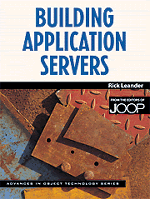Book contents
- Frontmatter
- Contents
- acknowledgements
- Introduction
- PART 1 ARCHITECTURE
- PART 2 DESIGN
- Chapter 3 Designing Application Servers
- Chapter 4 Service Interface Design
- Chapter 5 Designing Business Objects
- Chapter 6 Designing the Persistent Object Layer
- Chapter 7 Integrating Existing Systems and Legacy Software
- PART 3 PROGRAMMING
- Appendix: Setting up a Development Environment
- Index
Chapter 7 - Integrating Existing Systems and Legacy Software
from PART 2 - DESIGN
Published online by Cambridge University Press: 06 July 2010
- Frontmatter
- Contents
- acknowledgements
- Introduction
- PART 1 ARCHITECTURE
- PART 2 DESIGN
- Chapter 3 Designing Application Servers
- Chapter 4 Service Interface Design
- Chapter 5 Designing Business Objects
- Chapter 6 Designing the Persistent Object Layer
- Chapter 7 Integrating Existing Systems and Legacy Software
- PART 3 PROGRAMMING
- Appendix: Setting up a Development Environment
- Index
Summary
Legacy software—the words conjure up images of glass-walled rooms, guys with crew cuts, lab coats, and horned-rimmed glasses, COBOL, FORTRAN, RPG, ISAM, line printers, tape drives, and maybe even punch cards: everything that's ancient and evil, old and obsolete. This is the image that vendors want their customers to see as they show off their latest client/server tools. But in reality, legacy software is a core resource. Those ancient COBOL programs are the tools that keep the business running smoothly. If this were not true, the Y2K problem would never have been an issue and all of this ancient software would have been replaced long ago. It is a tribute to those old COBOL programmers that the code still plays an important part in their organizations 15 or 25 years later.
This chapter will examine how to integrate application server technology into the existing information system environment. Topics will include:
Design issues for application integration
Application mining
Turning subroutines into services
Input and output streams
Accessing application databases
Synchronizing transactions
Design Issues for Application Integration
When approaching application integration, remember that there is no one best solution. Integration tasks will vary depending on the hardware and software platforms, system architecture, communication links, data models, and a host of other factors. The level of integration may also vary based on the amount of information needed and the directions of data flow. A task may require a simple data transfer, or it may need to share procedural code. What worked when linking to the general ledger system may not work when accessing inventory.
- Type
- Chapter
- Information
- Building Application Servers , pp. 157 - 174Publisher: Cambridge University PressPrint publication year: 2000



